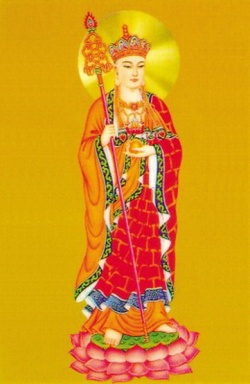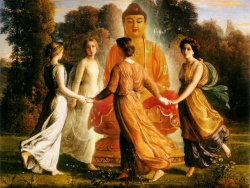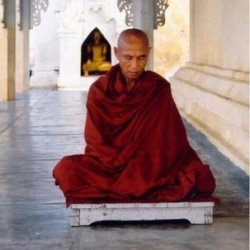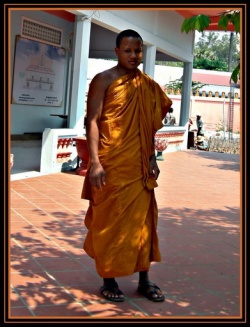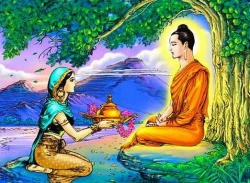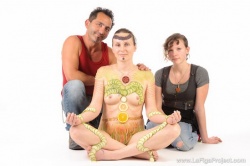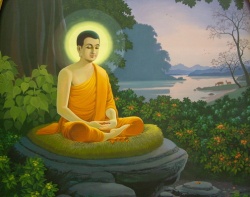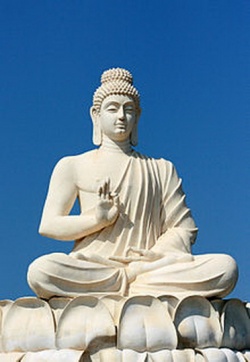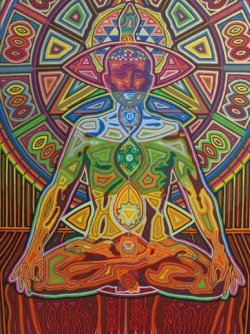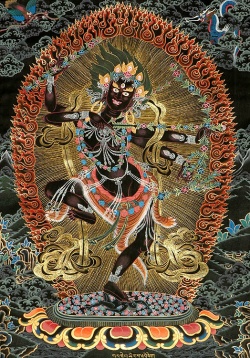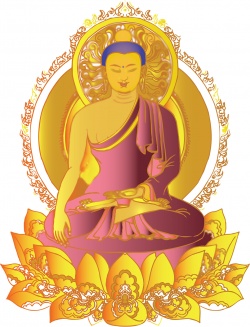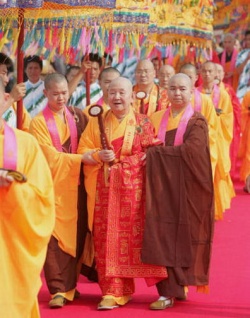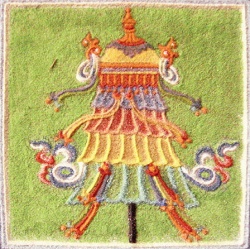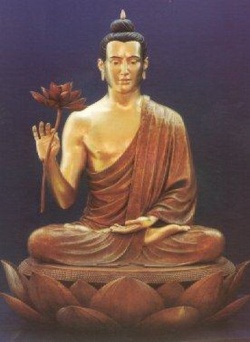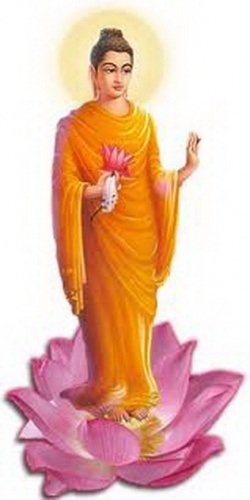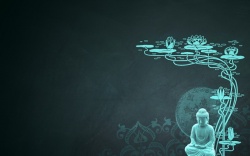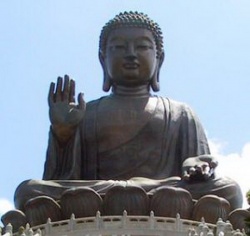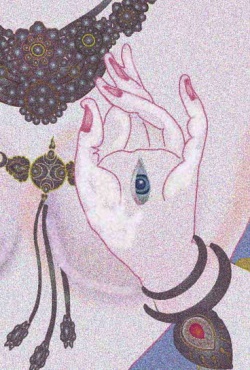The Yogacara: ''Vijnaptimatra'' is a Doctrine of Metaphysical Idealism ! (Class Essay)
Introduction:
Yogacara as a Mahayana
The Yogacara as a Mahayana school most probably evolved from a group of ancient Buddhist monks who were meditator in late 2ndcentury A.D,.1 School of meditators became a philosophic school under circumstances still poorly understood, but primarily under the influence of Maitreya-Asanga, as is well known.
It presented itself as a Sautrantika accommodated to an idealistic ontology; the existence of only the mind (cittamatra).2
It came to be known as the "consciousness-only" school in 4th century A.D. of Mahayana Buddhism. So that Yogacara is also known as Vijnanavada school of Buddhism, which rendered the “Doctrine of Consciousness”.
The origins of the scholarly Indian Yogacara tradition were rooted in the Nalanda University where the doctrine of Cittamatra was first extensively propagated.
Doctrines, tenets and derivatives of this school have influenced and become well-established in China, Tibet, Japan and Mongolia and throughout the World.
Yogacara discourse views that all phenomena is mind.
And most important Yogacara texts are discussed in the philosophical point of view: “Two sutras, the Sandhinirmocana,and the Lankavatara, a work of quite exceptional spiritual profundity.
Two short works of Vasubandhu, the ‘Twenty Verses’ with his own and the ‘Thirty Verses’ with Sthiramati commentary. Asanga’s Mahayana-samgraha with some excellent commentaries, and two works attributed to [[[Maitreyanatha]],i.e. the Mahayanasutralankara and the Madhyantavibhaga. And finally Yuan-tsang’s Vijnaptimatratasiddhi, which reflects chiefly the views of Dhammapala.”3
In this short writing I will try to maintain that the Yogacara is a form of Metaphysical Idealism, which is based on the doctrine of “Consciousness-only”(vijnaptimatra) and denies the external objects by asserting that there is nothing can be known to exist apart from consciousness which is a position of metaphysical idealism.4
I will further discuss about the Three-self Nature (trisvabhava) as empty of objective duality which amount the external objects as conceptualized/imagined productive nature of the world and comprise “Vijnaptimatrata” as the theory of absolute reality.
Yogacara doctrine
The main Yogacara doctrine of Eight Consciousnesses and, alayavijnana as their causes will be shown.
The notion of Cittamatra (Mind-only) or, Vijnaptimatra (Consciousness-only):
The Yogacara notion of vijnaptimatrata is an attempt to reformulate this basic Buddhist insight through a comprehensive phenomenological analysis of the activities of the mind.
In the systematized Yogacara school of Maitreyanatha, Asanga and Vasubandu, the pristine Absolute Consciousness or Vijnaptimatrata is the Absolute Reality.
Through individual Ignorance (Avidya), Vijnaptimatrata as the three vijnanas;
viz: Alayavijnana,Manas or Klishto manovijnana, and Pravrittivijnana, by which is meant the six consciousnesses - the five sense consciousnesses (seeing, hearing, etc.) and the manovijnana or mind consciousness-that make up mental and sensory reality.
The term, Cittamatra “Mind-only” is given by Asanga and later on his brother Vasubandhu developed as the doctrine of “Consciousness-only” (vijnaptimatra) in his Vijnaptimatratasiddhi-Trimsika .
Asanga's teaching contains in itself the tendency to ontological and metaphysical examination of the problem of Mind.
It confirms the existence not only the "store consciousness" of Alaya-vijnana which is the source of all empirical forms of consciousness and its contents as well but also supports the idea of the One and Only absolute Mind which is the same as the Dharma Body (Dharmakaya) of the Buddha itself.
Absolute Consciousness
This Absolute Consciousness sometimes was even called "Great Self", "Highest Self", or "Pure Self" (mahatman; paramatman; suddhatman).6
Unlike Asanga, Vasubandhu carefully reserves from the arguments of the ontological character having strong intention to keep himself exclusively in the frames of phenomenology. Developing the concept of "alaya-vijnana" and the teaching about three levels of reality (trisvabhava).7
In the section on the Mind (Manobhumi), citta, manas and vijnana-three terms hitherto (in the early sutra-s and in Abhidharma tradition) are considered as to the same entity.8 Mahayana, Vimshatika declares that, all the three worlds do not exist outside of thought.
Mind, thought, consciousness, knowledge are synonyms.9 (Consciousness–only) describes in the Lankavatara Sutra as Cittamatra (Mind-only).
In the general sense both of are synonym.
No one is saved as long as he conceives of an object and a subject.
If he should seek refuse in a ‘bare thought devoid of an external object’, he would still apprehend his own consciousness and thereby miss ‘the true nature of thought. Vasubandhu made a valiant attempt at excluding all misunderstanding by saying that; ‘When cognition no longer apprehends an object, then it stands firmly in consciousness-only; because where there is nothing to grasp there is no more grasping’.
The accomplished yogin does not take as real any object whatever outside Thought.10 This is most characteristic doctrine of the Yogacarins is their so-called 'idealism", it denies the independent reality of an external object.
Vasubandhu in his commentary of Vijnaptimatratasidhi-Trimsika proves that Pure-Consciousness is the Reality and there is no existence of external objects outside the thought. Reality, says the Trimsika, is pure consciousness.
This reality (Vijnaptimatra) on account of its inherent power suffers threefold modification.
First of all it manifests itself as Alayavijnana or Vipaka which is a Store-house Consciousness, where the seeds of all phenomena are present. In their doctrines concerning action, the Vijnanavadins rendered the theories of the Sautrantikas, even if with some retouches.
Action, which is essentially volitional, justifies the doctrine of ‘mind-only’.11
The mind as cause, the hand, which is a development of the mind, arise and dies in a series which propagates itself in space as if it were moving.
This movement appears to “inform” indicating the mind from whence it arises; it can be given name as bodily vijnapti.12 With the mind as cause, a voice or a series of syllables developing from the mind, arises and disappears.
proponents of consciousness
The Vijnanavada that consciousness can exist by itself without the object, as it admittedly does in dream-states and other illusions.
Consciousness should be regarded as giving rise to the varied contents of its states from its own inner potentiality.13
Vijnanavada analyses illusion from an opposite angle; for it, the ‘given’ is appearance, and the ideating consciousness alone is real.
The appearance of something, the ‘this’, independent of the act of cognition, is negated; and the true nature of the appearance as identical with the projecting consciousness is reinstated.14
Certain masters of the past have been obliged to admit that the mind is ultimately real and thereby originated the school of the Vijnanavada proponents of consciousness, which one of those is known at the present day as the four philosophical systems.
According to Lankavatara Sutra, says that;
There is Mind-only, there is no visible world;
As there is no visible world, [[[Mind]]) is not arisen [apart from Mind there is no rising];
This is taught by myself and other [[[Tathagatas]]) to be the Middle Path.15
The whole teaching of the Yogacarins or Vijnanavadins contends the doctrine of 'Cittamatra”(Mind-only), or, Vijnanamatra (Consciousness-only) in broadest sense of explanation.
Metaphysics and Idealism
Metaphysics is the branch of philosophy, investigating principles of reality transcending those of any particular science.
Cosmology and ontology are traditional branches of metaphysics.
It is concerned with explaining the ultimate nature of beings and the world.16
The word derives from the Greek word “meta” meaning “beyond” or “after” and word “physika” which meaning “physical”.
In Aristotelian metaphysics the principle of contradiction governs all that is (to on)17 “physical” referring to those works on matter by Aristotle in antiquity.
The prefix meta(beyond) was attached to the chapters in Aristotle’s work that physically followed after the chapters on “physics”.
More recently, the term “metaphysics” has also been employed by non-philosophers to refer to “subjects that are beyond the physical world”.
Metaphysical Idealism
Parmenides is one of the first meta-physicians. He held that the multiplicity of existing things, their changing forms and motion, are but an appearance of a single eternal reality (“Being”), thus giving rise to the Parmenide an principle that “all in one”.
From this concept of Being, he wanted to say that all claims of change of non-Being are illogical.
Because he introduced the method of basing claims about appearances on a logical concept of Being.
In philosophical way, the term ontology is interpreted as “the study of Being and existence”, includes the definition and classification of entities, physical or mental, the nature of their properties, and the nature of change. It is a branch of metaphysics.
The principle of Buddhist ontology is quite different, which is common to all schools and has been formulated on many occasions. 18 states that the truth “lies in the middle” between ‘it is’ and ‘it is not’.
Another proposal discussing the mind-body problem is ‘Idealism’, in which the material is sweepingly eliminated in favor of the mental.
The term “Idealism” came to vogue roughly during the time of Kant.
It defines that ideas are the only real things, whereas matters do not exist. Idealism, in its broadest sense, came to encompass everything that was not materialism.
Idealist, George Berkeley claims that material objects do not exist unless perceived and only as perceptions. On the other hand Materialist argued that only matter was ultimately real, so that thought and consciousness derived from physical entities (chemistry, brain state, etc).
Subsequently opposing camps took one or the other substance as their metaphysical foundation. The various forms of metaphysical idealism was posited a mind (or minds) as the ultimate reality. The physical world was either an unreal illusion or not as real as the mind that created it.19
Three Self-nature (Tri-Svabhava), Emptiness (Sunyata) and Consciousness-only (Vijnaptimatra);
The Three Self-nature theory (tri-svabhava), which is explained in many Yogacara texts including an independent treatise by Vasubandhu devoted to the subject (Trisvabhava-nirdesa-sastra), maintains that there are three “nature” or cognitive realms at play.
To Nagarjuna separate dharmas seemed illusory because logically impossible, to the Yogacarins because they were merely ideas or representations.
For them the external world is really mind itself, and illusion consists in regarding the objectifications of one’s own mind as a world independent of that mind which is really its source.
Things do not exist, in the sense that they are unreal as we imagine them to be.
They do not, however, not exist in each and every way because their inconceivable basis, called ‘the mere entity” (vastumatram), the ‘things in itself’, is real.
The Yogacarins evolved their theory of the ‘three kinds of own-being’, which part of Yogacarin doctrine is well documented,20 relatively easy to understand. These are referred to in Yogacara as the [[three natures]of perception]].
They are;
10 Parikalpita-svabhava, which literally means “fully conceptualized” or Imaginary Nature, wherein things are incorrectly apprehended based on conceptual construction, through attachment and erroneous discrimination.
It is conceptually constructed through imputes unreal conceptions.
First of all the world of common sense is considered just as it appears to ordinary people, composed of many things with their own attributes and names.
The Yogacarins add that it consists in that ‘something appears as an object when in fact there is none, but only an idea’21.
The common sense world is pure imagination, covering up the true reality (dharmata or dharmadhatu), which is that ‘the imagination of something which is actually unreal’ (abhutaparikalpita).
11 Paratantra-svabhava, which literally means “”casual dependency” or Dependent Nature, by which the correct understanding of the dependently originated nature of things is understood.
The nature of casual dependency develops, when mixed with the conceptual constructed nature.
Secondly, as regards the ‘interdependent’, we consider the various objects as they mutually cause and condition each other, and are causally dependent on one another, according to the formula ‘where this is, that becomes’.
The interdependent arising of dharmas ‘is the basis of the manifestation of non-existent and fictitious objects’22.
Though it does not appears, the ‘interdependent own-being’ is unlike the ‘imaginary own-being’, not entirely non-existent.
The characteristic feature of this knowledge is that it is not altogether a subjective creation produced out of pure nothingness, but it is a construction of some objective reality on which it depends for materials.
12 Parinispanna-svabhava, which literally means “fully accomplished” or Absolute Nature, through which one apprehends things as they are in themselves, uninfluenced by any conceptualization at all. It acts as an antidote (pratipaksa) that that cleans all delusional constructions out of the casual nature.
Thirdly we penetrate by means of pure thought to the absolute aspect of the data of experience.
Absolute knowledge, or ‘right cognition’, has immutable Suchness’23 for its object, and for it the empirical object does absolutely not exist in the manner in which it is imagined’24.
Sandhinirmocana sutra states that, “things have no existence at all, then they have no origination; if they have no origination, then they have no extinction. If they have no origination and no extinction, they are fundamentally quiescent.
If they are fundamentally quiescent, they are inherently nirvanic, and there is nothing at all therein that can further cause their ultimate nirvana.
Therefore I say that all things have no origination or extinction, are fundamentally quiescent and inherently nirvanic, in terms of the essencelessness of characteristics.” 25 produce explanations of the dependent and real natures based on the characteristics of the conceptualized nature, saying they are such and such, in accord with how people conceptualize them.
For Nagarjuna, when one reaches the conclusion of the analysis, one’s “seeing things as they truly are” is just seeing emptiness; later Indian Madhyamakas will speak of it as the “seeing that is non-seeing.” For Nagarjuna, emptiness is utter lack of essence; hence, they are all ultimately unreal.
For Asanga and Vasubandhu, emptiness is the absence of subject object duality in the mind of the perceiver.
There remains nevertheless the undeniable fact of consciousness itself.
Asanga and Vasubandhu explain their new notion of emptiness through the theory of the “three natures” (trisvabhava).26
Emptiness [[[sunyata]]) means 'absence of duality between perceiving subject and the perceived object."27 Response to the earliest Madhyamaka doctrine of emptiness and the Middle Way, the early Yogacara asserts that the true Middle Way consists in neither superimposing (samaropa) what do not actually exist -i.e. the conceptualized on these ‘thing-in-itself’, nor negating (apavada) what actually exist – i.e. these very things in themselves.28
Exist; devoid of the improper grasping superimposing what is unreal, and devoid of the improper grasping what is real, and is to be understood as the domain of the non-conceptualizing knowledge alone.
According to Ven. Prof. KL Dhammajoti that such doctrine of "consciousness-only" (vijnaptimatra) as a metaphysical theory is developed in the Yogacara texts. In the Treatise On the Three Natures (Trisvabhava-nirdesa), Vasubandhu clearly states that all outside things are just imagined, empty of duality and constructed by the mind.
“The imagined (kalpita), the other dependent (paratantra) and
The consummate (parinispanna).
These are the three natures (svabhava)
Which should be deeply understood.”
If anything appears, it is imagined.
The way it appears is as duality (dvaya).
What is the consequence of its non-existence?
The fact of non-duality (advayadharmata)!
What is the imagination of the non-existent?
Since what is imagined absolutely never
Exists in the way it is imagined,
It is mind that constructs that illusion." 29
Again in the Lankavatara-sutra clearly focused the concept of Mind-only (cittamatra) by categorization of being, non-being, and being-and-non-being that all are mind made and outside all objects are the creation of the mind.
What is seen, is seen of Mind wherein no existence of subjects and objects duality.
The Blessed One said to Mahamati in such way-- "When the world is seen [to be unpredictable with such notions as] being, non-being, or being-and-non-being, a change takes place in the mind, and egolessness is attained.
The external world is not, and multiplicity of objects is what is seen of Mind; body, property, and abode-these I call Mind-only (cittamatra).
Multiplicity of objects evolves from the conjunction of habit-energy and discrimination; it is born of mind, but is regarded by people as existing outwardly; this I call Mind-only."30
===The Doctrine of Eight-Cosciousnesses (Astavijnana) under the Reality of Mind==-
In the Yogacara School of Buddhism Vijnana are to be understood as ultimate reality of the world.
The most famous innovation of the Yogacara School was the doctrine of eight consciousnesses.
Generally we can find six consciousnesses in the early Buddhist Abhidharma, each consciousness produced by the contact between sense organ and a corresponding sense object.
But in the doctrine of the Yogacara school of Buddhism described a concept of the “Eight Consciousnesses”.
They enumerated the five senses, supplemented by the mind (manas), the "obscuration" of the mind (klesa), and finally the fundamental "store-house consciousness" (alayavijnana), which is the basis of other seven.
The translator Suzuki, in the Lankavatara-Sutra these Eight Consciousnesses described as follows;
-“When an object is presented before the eye, it is perceived and judged as a red apple or a piece of white linen;
the faculty of doing this is eye-vijnana.
In the same way there are ear-vijnana for sound, nose-vijnana for odour, tongue-vijnana for taste, body-vijnana for touch, and thought-vijnana (mano-vijnana) for ideas.
Of these six vijnanas, the Manovijnana is the most important as it is directly related to an inner faculty known as Manas.
The Manas first wills, and then it discriminates to judge.”31
Manovijnana became the sixth consciousness, surveying the cognitive content of the five senses as well as mental objects (thought, ideas).
Manas became the seventh consciousness, redefined as primarily obsessed with various aspect and notions of "self" and thus called "defiled manas" (klista-manas). The Eight-Consciousness is “Alayavijnana” or "store-house consciousness".
Individual self (klista manovijnana) depends on the Alaya and is accompanied by four kinds of suffering-self-notion, self-delusion, self-pride and self-love.32 Cease to function when the false notion of the ego is destroyed and when the categories of intellect are transcended.33
The third modification, the form of the objects, the mental states (manovijnana) and the so-called external objects (visaya-vijnana), which appears as the six Vijnana(sadvidha) is of two kinds- pure (kusala) and impure (akusula) and is accompanied by various suffering (klesha) and sub-suffering (upaklesha).34
Vijnanas stand in the same relation to the Alaya as waves stand to water.35 Thus we see that the subject as well as the object are only modifications of the Alaya which itself is only a modification of Pure Consciousness. Hence it is established that Pure Consciousness is the only Reality.
Vijnana is composed of the prefix “vi” meaning "to divide", and the root jna which means "to perceive", "to know". Thus, Vijnana is the faculty of distinguishing or discerning or judging. The terms citta, manas, vijnana,manovijnana, and alayavijnana are necessarily based on one, these all are synonym of the citta or vijnana.
Three modes are distinguishable in the Vijnanas
- (1) the Vijnana as evolving,
(2) the Vijnana as producing effects, and
(3) the Vijnana in its original nature.36
In the Vijnanas, which are said to be eight, two functions generally are distinguishable, the perceiving and the object-discriminating. Between the two, the perceiving Vijnana the object-discriminating Vijnana, there is no difference; they are mutually conditioning.
The perceiving Vijnana because of transformation’s taking place [in the mind) by reason of the mysterious habit-energy, while object-discriminating Vijnana functions because of the mind’s discriminating an objective world and because of the habit-energy accumulated by erroneous reasoning since beginningless time.37
Again the Buddha explained to Mahamati in Lankavatara-sutra, that the wise find the way of cessation and destroy the continuum samsaric existence through the understanding of Vijnanas and there is nothing than Mind itself.
Alayavijnana is the ultimate reality of the Doctrine of “Vijnaptimatra”:
Alayavijnana is one of eight consciousnesses was elaborated in Yogacara school of Buddhism.
In Buddhist sutras and agamas we can find the concept of alaya. In Asanga’s Mahayanasangraha-sastra a notable passage is quoted from the Tseng-i-a-han-ching [[[Ekottaragama Sutra]]) which discloses the existence of alayain four modes i.e., alayabhiharata(alaya-loved), alayarata (alaya-enjoyed), alayasamudita(alaya-indulge-in), and alayarama(alaya-delight-in).
Alayais interpreted here as “that which is loved and attached to by living beings.”38 Some scholars, like Suguro, in fact suggest that originally alaya-vijnana signifies the consciousness that clings to the self.39 Again, some people think that Alayavijnana “Store-consciousness” (Tathagathagarbha) of Mahayana Buddhism is something like a self.40
The second evolving consciousness which is called Manas as it was discussed in previous topic, and it manifest itself, with the alayavijnana as its basis and support, and takes that consciousness as object.41 to the Yogacarins, the mindless absorptions are endowed with mind from the fact of the alayavijnana.42 The Alayavijnana the universal storehouse consciousness, so-called because it is the repository of the vasanas (perfuming),the impressions or tendencies carried over from past lives.
D. T. Suzuki explains, "every act, mental or physical, leaves its seeds (bijas) behind, which is planted in the Alaya future germination under favourable conditions".43
Asanga (4thcen. A.C), a great authority of Yogacara school, who, from the standpoints of ‘non-self’, proposed for the first time the existence of alaya-vijnana, which acts as the subject in the cycle of births and deaths.
Based upon the teaching of the Mahayana-Abhidharma Sutra, and the Sandhinirmocana sutra, in which the persisting element within each individual is represented as alaya-vijnana or, a basic consciousness.
It is also called adana-vijnana (grasping-consciousness).44 [
[[[Vijnaptimatrata-trimsika]]]] the alaya-vijnanaas follows: “The first (transformation) is alaya-vijnana, and it is also called vipaka-vijnana (retributive consciousness) or sarvabijaka-vijnana(the consciousness carries within it all seeds).”45
In this three characteristic of this consciousness are distinguished, that is, alaya-vijnana as self-characteristic, vipaka as the effect-characteristic, and sarvabijaka as the cause-characteristic.
Again, the term alaya described in the earlier sutra-s as “attachment”, “clinging”. 46 was given a new term of the meaning of alayavijnana is the form of mind characterized by sticking in the material organs, in sense of being hidden in them.47
The Alayavijnana the Lankavatara which is identified with Tathagatagarbha or the Pure Citta is identical with the Vijnaptimatra of Vasubandhu. Both are pure Consciousness which is the permanent background of all phenomena, subjective as well as objective, and which ultimately transcends the subject and object duality.
The Alayavijnana Vasubandhu is only a phenomena manifestation of this Pure Consciousness. It contains the seeds of all phenomena, subjective as well as objective.48
The reality of Pure consciousness alone, variously called as alayavijnana [of the Lankavatara), Tathagatagarbha, Cittamatra, Vijnaptimatra, is empirically maintained.49 The alayavijnana considered as the cause of all eight consciousnesses, which implies all seeds into the store (alaya). As this consciousness is capable of holding and preserving such seeds, it is described as sarvabijaka in the Vijnaptimatrata-trimsika.
Sarvabijaka means ‘all seeds”, and sarvabijaka denotes the possession of all seeds by the eight consciousness which manifests them.
The theory, which asserts that this consciousness as it is possessed of all seeds causes all phenomena to appear, is technically called the theory of causation by the alayavijnana; and it is given the name of “Consciousness-only Doctrine” (vijnaptimatratavada) to the assertion that the manifestation of all things rest on consciousness.50
The alayavijnana the association factor of mind as it is described in the [[Alaya Treatise: Pravrttiand Nivrtti from the Viniscayasamgrahani of the Yogacarabhumisastra; (2.b) A. Alayavijnana is associated through association (samprayoga) with the five omnipresent factors associated with mind (cittasamprayuktasarvatraga): attention (manaskara), sense impression (sparsa), feeling (vedana), apperception (samjna), and volitional impulse (cetana).51
In the Manobhumi(the section of Mind) of Yogacara-bhumi-sastra, citta is given as a synonym of alayavijnana, and explained as follows; "What is citta? It is the alaya-vijnana which is, furnished with all seeds, furnished with the basis-nature, and subsumed as a retribution".52 Sandhinirmocana-sutra also says that alayavijnana is called citta.
The alayavijnana is the ultimate reality of producing all kinds of consciousnesses which transforms the “seeds of action” from past to present life and present to future life. It is root-consciousness (mula-vijnana) in the doctrine of “Vijnaptimatra”(Consciousness-only).
Final Declaration:
In the end of this easy I have come to point out that the doctrine of “Consciousness-only” is a metaphysical theory developed in Yogacara texts as Ven. Prof. KL Dhammajoti rightly understood.
There is no doubt that “Consciousness-only Doctrine” accepts the existence of consciousness itself as ultimate reality beyond external world as unreal, which similar to the theory of Metaphysics of Aristotle and takes all external things as just conception/imagination which is pure Idealism of Idealist, George Berkeley.
Whole three worlds are dominating by the mind and, the alayavijnana all seeds of consciousness in the “store” (alayate) for three life times. is much evidence that, the concept of Mind-only (cittamatra) or Consciousness-only (vijnaptimatra) as evidence of metaphysical idealism in the early Yogacara founded by Asanga and Vasubandhu.
Firstly, one should have to understand what Metaphysical Idealism is and later on he will understand about the doctrine of "Consciousness-only" that falls in the category of Metaphysics as well as Idealistic entity, which accept the concept of Mind as real beyond physical world as unreal or, concept.
Notes;
1 [[[Alaya-vijnana]]: The Yogacara Doctrine of the Store-consciousness, lectured by Ven. Prof. KL Dhammmajoti in IBC, lecture-1, 3, pp-1,1] 2 [[[Karmasiddhiprakarana]], The Treatise on Action by Vasubandhu, English translated by Leo M. Pruden, p.32] 3 [[[Buddhist]] Thought in India, by, Edward Conze, London, 1962, page-257]. 4 [[[Alaya-vijnana]]: The Yogacara Doctrine of the Store-consciousness, lectured by Ven. Prof. KL Dhammmajoti in IBC, lecture-3, p.-1] 5 [[[Wikipedia:Ashok Kumar Chatterjee|Ashok Kumar Chatterjee]], The Yogacara Idealism, Motilal Banaridass Publication, Delhi, 1999; p.87]. 6 Article; The Yogacara School of the Mahayana Buddhist Philosophy, by Evgueni A. Tortchinov; http://www.kheper.net/topics/Buddhism/Yogacara.html] 7 Ibid- 8 [[[Alaya-vijnana]]: The Yogacara Doctrine of the Store-consciousness, lectured by Ven. Prof. KL Dhammmajoti in IBC, Lecture-5, p.-2]. 9 [A Critical Survey of Indian Philosophy, by Dr. Candradgar Sharma, Motilal Banarsidass Publishers Private Limited, Delhi, p.-114]. 10 [[[Buddhist]] Thought in India, by, Edward Conze, Munshiram Manoharlal Publishers Pvt. Ltd, New Delhi, p-257] 11 [[[Karmasiddhiprakarana]], by Vasubandhu and translated into English by Leo M. Pruden, page-32]. 12 Ibid- 13 [[[yatha]] Taranga mahato’mburaseh samiranapreranay obdhavanti; tatha layakhyad api sarvabijad vijnanamatram bhavati svasakteh. Madhyamak-Avatara of Candrakirti; Chap-VI, p.- 46]. 14 [The Central Philosophy of Buddhism, by T.R.V. Murti, Munshiram Manoharlal Publishers Pvt. Ltd, New Delhi, p.-332]. 15 [[[Lankavatara Sutra]], translated by D.T. Suzuki, Motilal Banarsidass Publishers Private Limited, Delhi, p.-254, verse-358] 1 6 Geisler, Norman L. “Baker Encyclopedia of Christian Apologetics” p; 446. Baker Books, 1999 1 7 Der Satz vom Widerspurch, E. Conze, 1932, p;92-5 1 8 Samyutta Nikaya II, p:17 19 The Buddhists Encyclopedia of Buddhism by, Subodh Kapoor, Volume-5, Cosmo Publications, New Delhi 2001, p;1503 20 [[[Sandhinirmocana Sutra]], translated by Thomas Cleary, access date; 03/09/08, Lankavatara Sutra, pp-67-8, 130-3 21 [[[Mahayanasamgraha]], trad. E. Lamotte, La somme du grand vehicule d’Asanga, 2 vols., 1938-9, p.-90] 22 [[[Mahayanasamgraha]], pp-89,107]. 23 [[[Lankavatara Sutra]], translated by D.T. Suzuki, Motilal Banarsidass Publishers Private Limited, Delhi, p.-68] 24 [[[Mahayanasamgraha]] p.-110]. 25 Sandhinirmocana Sutra, translated by Thomas Cleary, http://www.empty-universe.com/yogacara/samdhinirmocana.htm, access date; 03/09/08] 26 [[[Mahayana Buddhism]], Lecture on The Two Truth, lecture held by Dr. Faqing in IBC on 09/09/08; http://ibc.ac.th/faqing/files/madoc/06_Madhyamaka%20two%20truth.pdf] 27 [[[Skilton]], Andrew. A Concise History of Buddhism. Windhorse Publications, London:1994. p.-124] 28 [[[Alayavijnana]]: The Yogacara Doctrine of the Store-consciousness, Lecture-4, p.-2 lecture held by, Ven: Prof. KL Dhammajoti in IBC] 29 Trisvabhava-nirdesa by Vasubandhu;Translated by Jay Garfield, access date; 03/09/08 30 [[[Lankavatara Sutra]], translated by D.T. Suzuki, Motilal Banarsidass Publishers Private Limited, Delhi, pp.-132-33] 31 [Ibid- p.xxiii] 32 [The Vijnaptimatratasiddhi-Trimsika, By Vasuhandhu: http://www.empty-universe.com/yogacara/trimsika.htm; K.6 accessed date 03/09/08]. 33 [Ibid, K.7] 34 [Ibid, K-8-9] 35 [Ibid, K. 15]. 36 [[[Lankavatara Sutra]], translated by D.T. Suzuki, Motilal Banarsidass Publishers Private Limited, Delhi, p.-33] 37 Ibid-----p.34 38 [[[Wikipedia:Encyclopedia|Encyclopedia]] of Buddhism, Vol-I, Apa-Bharhut 1966, Published by the government of Ceylon, p-383] 39 [ Alayavijnana: The Yogacara Doctrine of the Store-consciousness, Ven: Prof: KL Dhammajoti, Lecture-4; p.-3] 40 [What the Buddha Taught, by Walpola Rahula, p.-65] 41 [[[Vijnaptimatrata Trimsika]], by Vasubandhu; http://www.empty-universe.com/yogacara/trimsika.htm K-5, access date: 03/09/08]. 42 [[[Abhidhamma]] Kosa Bhasyam, by, Louis De La Vallee Pousin, En-Leo M. Pruden, p.-42]. 43 [[[Wikipedia:D. T. Suzuki|D. T. Suzuki]] Studies in the Lankavatara Sutra, Motilal Banarsidass Publishers Private Limited, p.483]. 44 [[[Alayavijnana]]: The Yogacara Doctrine of the Store-consciousness, lectured by Ven: Prof: KL Dhammajoti in IBC, Lecture-4; p.-3]. 45 [[[Vijnaptimatratasidhi-Trimsika]], by Vasubandhu; http://www.empty-universe.com/yogacara/trimsika.htm;verse-2; accessed date; 03/09/08] 46 [[[Alayavijnana]]: The Yogacara Doctrine of the Store-consciousness, lectured by Ven: Prof: KL Dhammajoti in IBC, Lecture-3, p.-5]. 47 [Ibid, lecture-3, p. 8]. 48 [A Critical Survey of Indian Philosophy, by Dr. Candradgar Sharma, Motilal Banarsidass Publishers Private Limited, Delhi, p-117] 49 [A Critical Survey of Indian Philosophy, by Dr. Chandradhar Sharma, Delhi, p. 121] 50 [[[Wikipedia:Encyclopedia|Encyclopedia]] of Buddhism, Vol-I, Apa-Bharhut 1966, Published by the government of Ceylon, p.-385]. 51 date; 05/09/08 52 [[[Alaya-vijnana]]: The Yogacara Doctrine of the Store-consciousness, lectured by Ven. Prof. KL Dhammmajoti in IBC, Lecture-5, pp-1,2].
Dr. Chandradhar Sharma; A Critical survey of Indian Philosophy, Motilal Banarsidass publishers Private Limited, Delhi
Apa-Bharhut, Encyclopedia of Buddhism, Vol-I, published by the government of Ceylon, 1966.
Ashok Kumar Chatterjee, The Yogacara Idealism, Motilal Banaridass Publishers, Delhi, 1999
Edward Conze; Buddhist Thought in India, Munshiram Manoharlal Publishers Pvt. Ltd. New Delhi.
Louis De La Vallee Pousin, translated in English by, Leo M. Pruden; Abhidharma Kosa Bhasyam, Vol-1
Louis De La Vallee Pousin, English translated by, Leo M. Pruden, Karmasiddhiprakarana, Asian humanities Press, Berkeley, California, 1988.
Ven: Prof; Dr. KL. Dhammajoti Lecture notes; on Alayavijnana: The Yogacara Doctrine of the Store-consciousness, IBC.
Compiler and Editor, Subodh Kapoor, The Buddhists Encyclopedia of Buddhism; Vol-5, Cosmo Publications, New Delhi 2001.
T.R.V. Murti; The Central Philosophy of Buddhism, Munshiram Manoharlal Publishers Pvt. Ltd. New Delhi.
Translated by D.T. Suzuki, The Lankavatara Sutra, Motilal Banarsidass Publishers Private Ltd. Delhi
Walpola Rahula; .What the Buddha Taught,
Handout Notes: Mahayana Buddhism, Lecture on The Two Truth, lecture held by Dr. Faqing in IBC on 09/09/08
Internet Source: http://www.yogacara.net/article/wisdom/philosophy/buddhist+philosophy/yogacara
Internet Source: http://www.kheper.net/topics/Buddhism/Yogacara.html Internet Source: http://www.empty-universe.com/yogacara Internet Source: http://en.wikipedia.org/wiki/Metaphysics
